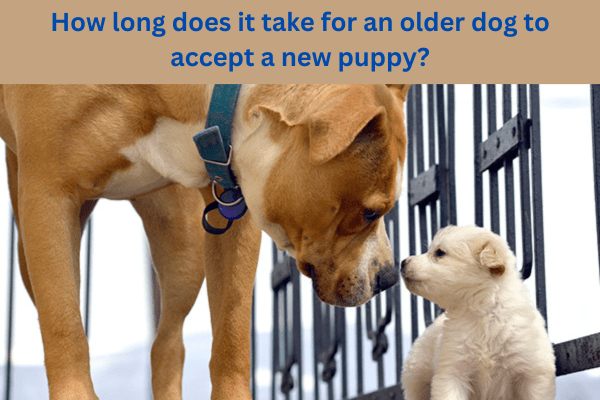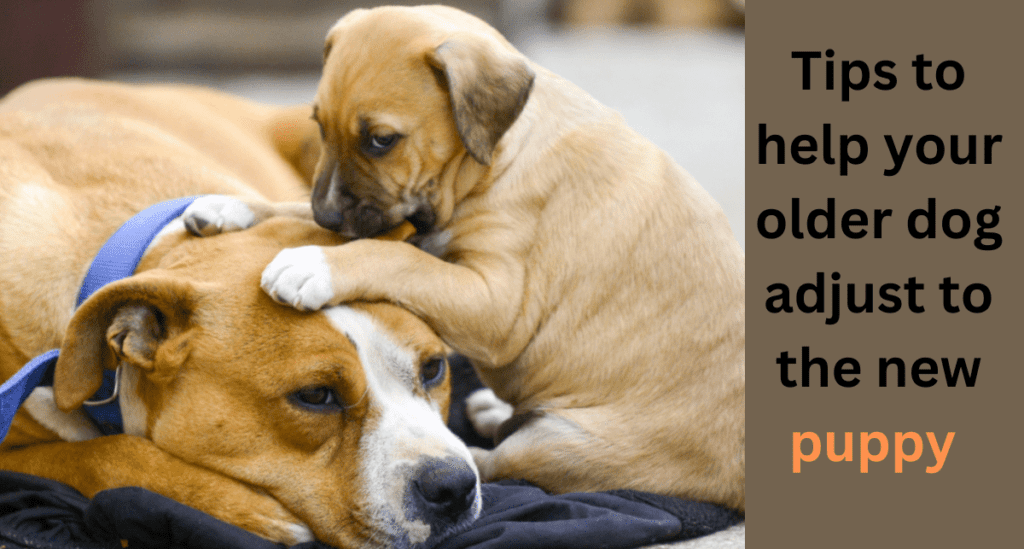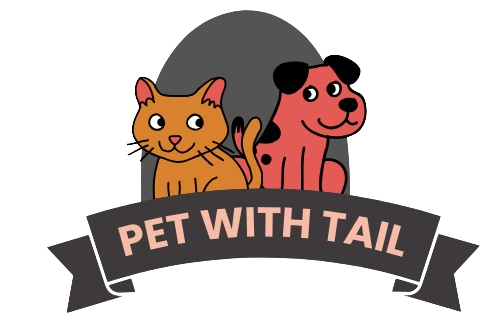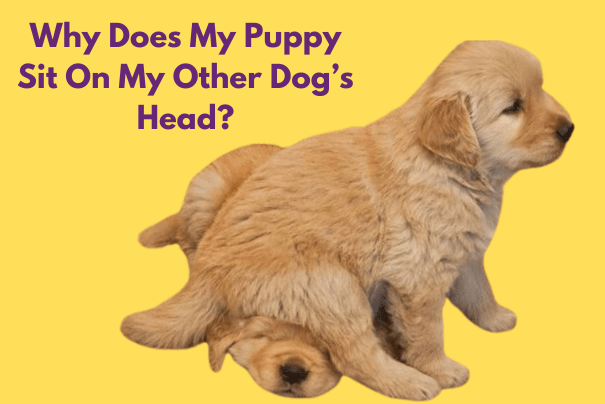If you have a puppy and an older dog, you may have noticed that sometimes the puppy likes to sit on the other dog’s head. This may seem like cute or funny behavior, but what does it mean? Is it a sign of dominance, affection, or something else?
Why does my puppy sit on my other dog’s head? There are different possible reasons, and they may depend on the context, the personality of the dogs, and their relationship. Here are some of the most common explanations:
Contents
Different possible reasons Why does my puppy sit on my other dog’s head?
Puppy Power Play
Puppies are naturally playful and curious, and they often engage in rough-and-tumble games with other dogs. Sitting on another dog’s head may be a way of initiating or continuing a play session, or showing off their energy and confidence.
The puppy may also be mimicking the behavior of the older dog, who may have done the same thing to them when they were younger. If the older dog does not mind or responds positively, then this is likely a harmless and fun interaction.
Dog Head Sitting Behavior
Some dogs may have a habit of sitting on other dogs’ heads, regardless of their age or size. This may be a way of expressing their dominance or leadership over the other dog or simply a comfortable position for them.
Some dogs may also do this to get attention from their owners or other people, or to block the other dog’s view of something they want. If the older dog shows signs of discomfort, submission, or aggression, then this may indicate a problem with the hierarchy or the relationship between the dogs.
Puppy Dominance Or Affection
Puppies may also sit on another dog’s head to show their dominance or affection. Dominance is not necessarily a bad thing, as long as it is established and maintained respectfully and peacefully.
Puppies may sit on another dog’s head to assert their authority or challenge the older dog, especially if they are going through a rebellious phase. Affection is also a possible motive, as puppies may sit on another dog’s head to cuddle, groom, or comfort them. This may be more common among dogs that are closely bonded or related.
Dog Social Etiquette
Dogs have their own social rules and etiquette, which they learn from their mother and their littermates, and from interacting with other dogs. Sitting on another dog’s head may be a part of their social code, which may vary depending on the breed, the culture, and the individual.
For some dogs, sitting on another dog’s head may be a sign of respect, friendship, or submission. For others, it may be a sign of disrespect, challenge, or aggression. It is important to observe the body language and the vocalizations of both dogs to understand the meaning and the intention behind the behavior.
Dog Non-Verbal Communication
Dogs communicate with each other and with humans through a variety of non-verbal cues, such as eye contact, facial expressions, body posture, tail wagging, ear position, and scent. Sitting on another dog’s head may be a way of sending a message or a signal to the other dog, the owner, or other people.
The message may be positive or negative, depending on the context and the tone. For example, a puppy may sit on another dog’s head to say “I love you”, “I want to play”, “I’m sorry”, “I’m bored”, “I’m in charge”, or “I’m annoyed”.
How do I stop my puppy from dominating my older dog?
Puppies are adorable and playful, but sometimes they can be too assertive or aggressive towards older dogs. This can cause problems in the household, as the older dog may feel threatened, stressed, or unhappy. How can you stop your puppy from dominating your older dog, and foster a harmonious and respectful relationship between them?
The First Step
The first step is to understand why your puppy is behaving this way. There are different possible reasons, such as:
- Lack of socialization: Your puppy may not have learned the proper social skills and etiquette from their mother their littermates, or other dogs. They may not know how to read the signals and boundaries of the older dog, or how to communicate their intentions and emotions.
- Rebellious phase: Your puppy may be going through a developmental stage where they are testing their limits and challenging the authority of the older dog. They may be trying to establish their position in the hierarchy or to assert their independence and confidence.
- Personality clash: Your puppy and your older dog may have incompatible personalities or preferences. They may have different energy levels, play styles, or temperaments. They may not get along well or enjoy each other’s company.
The Second Step
The second step is to intervene and correct your puppy’s behavior. There are different possible ways to do this, such as:
- Positive reinforcement: You should reward your puppy for behaving well and respecting the older dog. You should give them praise, treats, toys, or attention when they are calm, gentle, or submissive. You should also reward the older dog for tolerating or playing with the puppy, and for showing leadership or guidance.
- Negative reinforcement: You should discourage your puppy from misbehaving and disrespecting the older dog. You should give them a firm “no”, a loud clap, or a spray of water when they are rough, rude, or dominant. You should also separate them or put them in time-out if they are too aggressive or persistent.
- Training and exercise: You should train your puppy to obey basic commands, such as “sit”, “stay”, “leave it”, or “drop it”. This will help you control their impulses and actions, and teach them manners and discipline. You should also provide them with enough exercise and stimulation, such as walks, games, or toys. This will help them burn off their excess energy and boredom, and reduce their frustration and aggression.
The Third Step
The third step is to monitor and manage the relationship between your puppy and your older dog. There are different possible ways to do this, such as:
- Supervision: You should always supervise the interactions between your puppy and your older dog, especially in the beginning. You should watch out for any signs of trouble, such as growling, snarling, biting, or fighting. You should intervene and separate them if necessary, and prevent any injuries or escalations.
- Space and resources: You should provide your puppy and your older dog with enough space and resources, such as beds, bowls, toys, or bones. You should respect their individual needs and preferences, and avoid any competition or conflict. You should also give them equal attention and affection, and avoid any favoritism or jealousy.
- Socialization and introduction: You should socialize your puppy with other dogs and people, and expose them to different situations and environments. This will help them learn the proper social skills and etiquette, and become more confident and adaptable. You should also introduce your puppy and your older dog gradually and carefully, and let them get to know each other at their own pace. You should use neutral and safe locations, such as a park or a friend’s house, and avoid any stress or pressure.
By following these steps, you can stop your puppy from dominating your older dog, and help them develop a healthy and happy relationship. Remember that every dog is different and that it may take some time and patience to achieve the desired results. However, with consistent and positive guidance, you can enjoy the company of both your puppy and your older dog, and create a peaceful and loving household. 🐾
How long does it take for an older dog to accept a new puppy?
How long does it take for an older dog to accept a new puppy? This is a common question that many dog owners have when they bring home a new addition to their family. The answer depends on several factors, such as the personality, age, and history of the dogs, the way they are introduced, and the amount of supervision and training they receive.

In general, it may take about three weeks for the dogs to get used to each other and establish a peaceful coexistence. However, some dogs may need more or less time, depending on how they react to the new situation.
The key is to be patient, positive, and consistent, and to provide each dog with their own space, resources, and attention. By doing so, you can help your older dog accept the new puppy and create a harmonious household. 🐾
How do I know if my older dog likes the new puppy?
That’s a great question. It can be hard to tell if your older dog is happy with the new addition to your family, or if they are feeling stressed or annoyed by the puppy. Here are some signs that your older dog likes the new puppy:
- They play together. If your older dog initiates or engages in play with the puppy, that’s a good sign that they enjoy their company. Play can include chasing, wrestling, nipping, or tug-of-war. However, make sure that the play is not too rough or one-sided, and that both dogs are having fun.
- They groom each other. If your older dog licks or nibbles the puppy, or allows the puppy to do the same to them, that’s a sign of affection and trust. Grooming is a way for dogs to bond and show care for each other.
- They share resources. If your older dog is willing to share their toys, food, water, bed, or other items with the puppy, that’s a sign of generosity and tolerance. However, you should still provide separate bowls and beds for each dog, and supervise them when they have access to toys or treats, to prevent any resource guarding or fights.
- They relax together. If your older dog and the puppy can nap, cuddle, or rest together, that’s a sign of comfort and security. It means that they feel safe and calm in each other’s presence and that they have a positive association with each other.
If your older dog is stressed or unhappy with the puppy
If you notice any of these behaviors, you can be confident that your older dog likes the new puppy, or at least tolerates them well. However, if you notice any of the following signs, your older dog may be stressed or unhappy with the puppy:
- They avoid or ignore the puppy. If your older dog tries to get away from the puppy or shows no interest in interacting with them, that’s a sign of disapproval or indifference. Your older dog may prefer to be left alone, or may not want to deal with the puppy’s energy or antics.
- They growl or snap at the puppy. If your older dog warns or corrects the puppy with a growl, snarl, or snap, that’s a sign of annoyance or frustration. Your older dog may be trying to teach the puppy some manners or to respect their boundaries or personal space. However, if the growling or snapping is frequent or intense, it could escalate to aggression or a fight.
- They show signs of stress or anxiety. If your older dog exhibits any physical or behavioral changes that indicate stress or anxiety, such as panting, drooling, shaking, hiding, pacing, whining, or loss of appetite, that’s a sign of distress or fear. Your older dog may be overwhelmed or threatened by the puppy or may feel insecure or jealous of the attention they get.
- If you notice any of these signs, you should take steps to help your older dog cope with the new puppy and to prevent any potential conflicts or injuries.
Suggested: My Dog Was Attacked And Now Won’t Eat
Why Is My Dog Obsessed with My Belly Button?
Tips to help your older dog adjust to the new puppy
Some tips to help your older dog adjust to the new puppy are:
- Introduce them gradually and carefully. When you first bring the new puppy home, introduce them to your older dog in a neutral and spacious location, such as a park or a friend’s house. Keep both dogs on a leash, and let them sniff and greet each other calmly. Praise and reward both dogs for positive interactions, and intervene if there is any tension or aggression. Repeat this process until both dogs are comfortable with each other, and then bring them to your home.
- Give your older dog plenty of attention and affection. Your older dog may feel neglected or replaced by the new puppy, so make sure to spend quality time with them every day. Give them extra cuddles, praise, treats, and playtime, and let them know that they are still loved and valued. You can also involve your older dog in the training and socialization of the new puppy, and reward them for being a good role model and mentor.
- Provide your older dog with a safe and quiet space. Your older dog may need some time and space away from the puppy, especially if they are tired, sick, or stressed. Provide your older dog with a crate, bed, or room where they can retreat and relax, and make sure the puppy does not bother them there. You can also use calming products, such as Adaptil collars, sprays, or diffusers, to help your older dog feel more comfortable and secure.
By following these tips, you can help your older dog and the new puppy develop a harmonious and happy relationship. Remember to be patient and consistent, and to monitor their interactions closely. With time and guidance, your older dog and the new puppy will become the best of friends. 🐶❤️🐶

Should I walk my puppy with my older dog?
Walking your puppy with your older dog can have many benefits, such as providing exercise, socialization, and bonding opportunities for both dogs. However, it can also pose some challenges, such as different walking speeds, energy levels, and distractions. Therefore, before you walk your puppy with your older dog, you should consider the following factors:
- The temperament and health of both dogs. Some older dogs may enjoy the company and stimulation of a younger dog, while others may prefer a more calm and quiet walk. Some puppies may be eager to explore and play, while others may be shy or fearful. Some dogs may have health issues or injuries that limit their mobility or endurance. You should assess the personality and physical condition of both dogs and respect their individual needs and preferences.
- The training and leash skills of both dogs. Walking two dogs at the same time can be challenging, especially if one or both dogs are not well-trained or leash-savvy. You should make sure that both dogs know basic commands, such as sit, stay, and heel, and that they can walk politely on a leash without pulling, lunging, or tangling. You should also use appropriate equipment, such as harnesses, collars, and leashes, that fit well and are comfortable for both dogs.
- The environment and safety of both dogs. Walking your puppy with your older dog can expose them to various stimuli, such as other dogs, people, traffic, noises, and smells. You should choose a suitable location and time for your walk, where both dogs can feel safe and relaxed. You should also be aware of the potential hazards, such as heat, cold, parasites, or toxins, and protect both dogs accordingly. You should also monitor both dogs’ body language and behavior, and intervene if there is any sign of stress, discomfort, or aggression.
By considering these factors, you can decide whether walking your puppy with your older dog is a good idea, and how to make it a positive and enjoyable experience for both dogs. Remember to be patient and consistent, and to reward both dogs for good behavior. Walking your puppy with your older dog can be a great way to strengthen your bond and improve your dog’s well-being. 🐾
Conclusion
Why does my puppy sit on my other dog’s head? As you can see, there are many possible reasons and they may not always be obvious or easy to interpret. The best way to understand this behavior is to observe the whole situation, the history and the relationship of the dogs, and their personalities and preferences.
If the behavior is causing any trouble or distress to either dog, the owner, or other people, then it may be necessary to intervene and correct it, or to seek professional help from a veterinarian or a dog trainer. However, if the behavior is harmless and playful, then it may be best to let the dogs be dogs and enjoy their unique and adorable way of expressing themselves. 🐶




